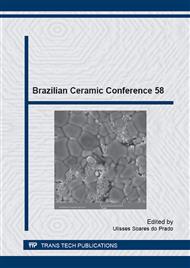[1]
S.N. Monteiro, C.M.F. Vieira: Ceramics Intern. Vol. 30 (2004), p.381.
Google Scholar
[2]
S.N. Monteiro, C.M.F. Vieira: Construc. Build Mater. Vol. 68 (2014), p.599.
Google Scholar
[3]
J.A. Cusidó, C. Soriano: Waste Managem Vol. 31 (2011), p.1372.
Google Scholar
[4]
C.A.C.M. Dias, S.N. Monteiro, R.T. Faria: Mater Sci Forum Vols. 727-728 (2012), p.715.
Google Scholar
[5]
J.A. Cusidó, L.V. Cremades: Waste Managem Vol. 32 (2012), p.1202.
Google Scholar
[6]
L.C.S. Herek, C.E. Hori, M.H.M. Reis, N.D. Mora, C.R.G. Tavares, R. Bergamasco: Ceram Intern. Vol. 38 (2012), p.951.
Google Scholar
[7]
J.A. de la Casa, I. Romero, J. Jiménez, E. Castro: Ceram Intern. Vol. 38 (2012), p.5027.
Google Scholar
[8]
D. Eliche-Quesada, S. Martínez-Martínez, L. Pérez-Villarejo, F.J. Iglesia-Godino, C. Martínez-Garcia, F.A. Corpas-Iglesia: Fuel Process Technol. Vol. 103 (2012), p.166.
DOI: 10.1016/j.fuproc.2011.11.013
Google Scholar
[9]
D. Eliche-Quesada, F.A. Corpas-Iglesia, L. Pérez-Villarejo, F.J. Iglesia-Godino: Constr Build Mater. Vol. 34 (2012), p.275.
Google Scholar
[10]
O. Kizinievič, R. Žurauskienė, V. Kizinievič, R. Žurauskas: Constr Build Mater. Vol. 41 (2013), p.464.
DOI: 10.1016/j.conbuildmat.2012.12.041
Google Scholar
[11]
L. Barbieri, F. Andreola, I. Lancellotti, R. Taurino: Waste Managem Vol. 33 (2013), p.2307.
Google Scholar
[12]
Brazilian Association of Technical Norms. Solid waste – Classification. Rio de Janeiro: ABNT 2004. (NBR-10. 004). (In Portuguese).
Google Scholar
[13]
American Society for Testing and Materials - ASTM D5373-14, Standard Test Methods for Determination of Carbon, Hydrogen and Nitrogen in Analysis Samples of Coal and Carbon in Analysis Samples of Coal and Coke, USA, (2014).
DOI: 10.1520/d5373-13
Google Scholar
[14]
American Society for Testing and Materials - ASTM D4239-14, Standard Test Method for Sulfur in the Analysis Sample of Coal and Coke Using High-Temperature Tube Furnace Combustion, USA, (2014).
DOI: 10.1520/d4239-13
Google Scholar
[15]
Brazilian Association of Technical Norms. Coal - Determination of moisture - Test method. Rio de Janeiro: ABNT 1983. (NBR-8293). (In Portuguese).
Google Scholar
[16]
Brazilian Association of Technical Norms. Coal - Determination of volatile materials - Test method. Rio de Janeiro: ABNT 1983. (NBR-8290). (In Portuguese).
Google Scholar
[17]
Brazilian Association of Technical Norms. Coal - Determination of ash - Test method. Rio de Janeiro: ABNT 1987. (NBR-8290). (In Portuguese).
Google Scholar
[18]
Brazilian Association of Technical Norms. Coal - Determination of fixed carbon - Test method. Rio de Janeiro: ABNT 1983. (NBR-8299). (In Portuguese).
Google Scholar
[19]
American Society for Testing and Materials - ASTM D5865-13, Standard Test Method for Gross Calorific Value of Coal and Coke, USA, (2013).
Google Scholar
[20]
Brazilian Association of Technical Norms. Soil - Granulometric Analysis. Rio de Janeiro: ABNT 1988. (NBR-7181). (In Portuguese).
Google Scholar
[21]
P.S. Santos: Science and Technology of Clays. (Edgard Blucher, 2nd ed. vol. 1 São Paulo, 1989) (In Portuguese).
Google Scholar


